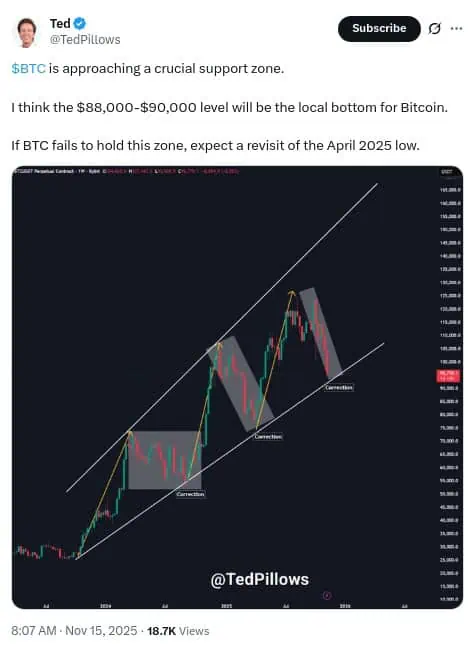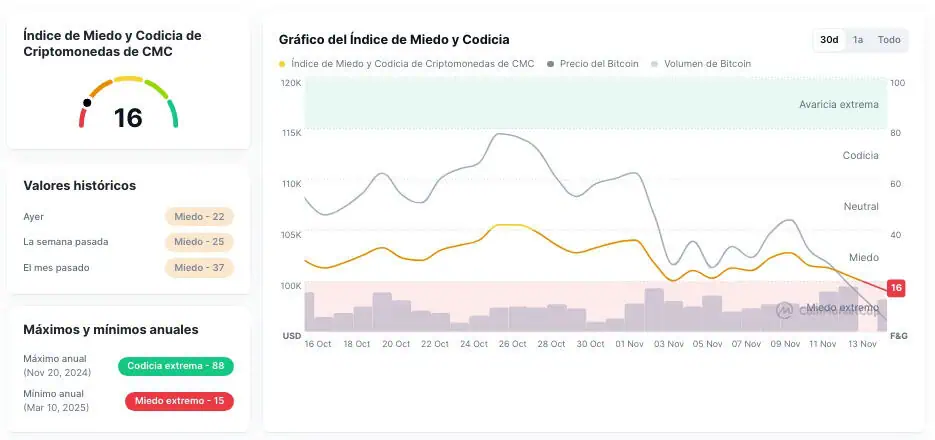
Bitcoin's price has fallen 25% since October, but analysts and institutional investors see signs of consolidation, not collapse. Are we witnessing a healthy correction or the prelude to a new rally?
Since mid-October, Bitcoin has lost nearly a quarter of its value, falling from 126.000 to 94.000 dollarsFor many, this pullback has set off alarm bells. But for those familiar with the cycles of the crypto market, this drop doesn't represent a sign of weakness, but rather an expected phase within a broader upward trend.
In this article, we explore what is really happening with Bitcoin, what the technical indicators are saying, and how institutional players are reacting to market fears.
Bitcoin is pulling back. Take advantage and trade on Bit2Me.A 25% drop that doesn't surprise Bitcoin veterans
Volatility is part of Bitcoin's DNA. Since its inception, the cryptocurrency has gone through multiple cycles of euphoria and correction. Therefore, what today seems like a sharp drop to many—from $126.000 to $94.000 in just a few weeks—represents a 25,5% decline which, for others, is perfectly within the range of normal corrections in bull markets, which usually range between 20% and 35%.
These types of price corrections are not only expected, but often act as market cleansing mechanisms: they eliminate excess leverage, adjust expectations, and allow for healthier accumulation in the medium and long term. In this context, several analysts agree that Bitcoin is approaching a key technical support zone Between $88.000 and $90.000. Crypto analyst Ted Pillows said In X, if the leading cryptocurrency manages to stay within that range, it could mark a local low before a new recovery phase. Otherwise, the market could retest the lows seen last April.

Furthermore, other analysts point out that Bitcoin is nearing the closing of its CME gap at $92.000, a technical zone that historically acts as a price magnet. Many traders expect this gap to be filled before any sustained rebound.
But, beyond the charts, market sentiment has also changed dramatically. Bitcoin's fear and greed index fell to 16This indicates “extreme fear.” This is the lowest level since the COVID-19 pandemic crisis, and it reflects an atmosphere of uncertainty that, paradoxically, is often fertile ground for opportunities.

Source: CoinMarketCap
Smart money buys when there is fear
Amid the current volatility dominating the cryptocurrency market, many retail investors reacted by selling their Bitcoin positions out of fear of a downturn. However, not everyone shares this negative view. Some institutional players They are taking advantage of this opportunity to strengthen their portfolios.
Michael Saylor, CEO of Strategy and one of Bitcoin's biggest corporate advocates, is among those profiting from the BTC price drop. Saylor announced that your company bought BTC every day this week. Their counter-trend strategy demonstrates a fundamental principle in the world of cryptocurrencies: Smart money comes in when others go outThat is, when the market is in a state of uncertainty or fear.

For market experts, this behavior or strategy is nothing new. Since BlackRock launched its Bitcoin ETF some 30 months ago, the cryptocurrency has risen by more than 300%, equivalent to an annualized return of nearly 80%. Even with the current dip, Bitcoin has accumulated a 260% gain since that milestone. This data shows that, in the long run, Bitcoin's bullish narrative remains intact.
Saylor accumulates BTC. Trades on Bit2Me.Polymarket traders have also projected that Bitcoin could remain around $90.000 this month, a forecast that makes sense given the macroeconomic environment, where events such as the temporary government shutdown, adjustments to interest rates, and various stimulus measures are already priced in.
In other words, while some see the current correction as a sharp drop, others interpret it as an accumulation phase, underscoring that Bitcoin has not lost its bullish narrative and is simply consolidating, pulling back, and building up fuel for its next move.
What's next for the price of Bitcoin?
The key is understanding that Bitcoin cycles aren't measured in weeks, but in years. Every correction, every pullback, every moment of extreme fear has historically been an opportunity to position oneself before the next rally. And although Nobody can predict the future Certainly, analysts, technical data, and institutional behavior suggest that we are in a phase of consolidation, not collapse.
The support level between $88.000 and $90.000 will be crucial, according to experts. If it holds, it could mark the bottom of the current price correction. If it breaks, the market could seek new local lows. But even in that scenario, the long-term narrative remains positive, especially considering the growing interest from institutional players, the maturing ecosystem, and the development of new products that could open the door to a new wave of capital.
For retail investors, the biggest challenge is emotional. However, prominent figures like Michael Saylor demonstrate that buying during times of fear, when prices are falling and news generates pessimism, can be the key to avoiding impulsive decisions and building a solid, well-founded strategy.
Thus, while some are giving in to panic and selling hastily, a group of investors is taking advantage of the moment to position themselves with a long-term strategic visionAccording to experts, in financial markets, both traditional and digital, true strength is shown not in moments of euphoria, but in the ability to remain calm and act with perspective when uncertainty prevails.
Buy BTC on Bit2Me: easy and secure


